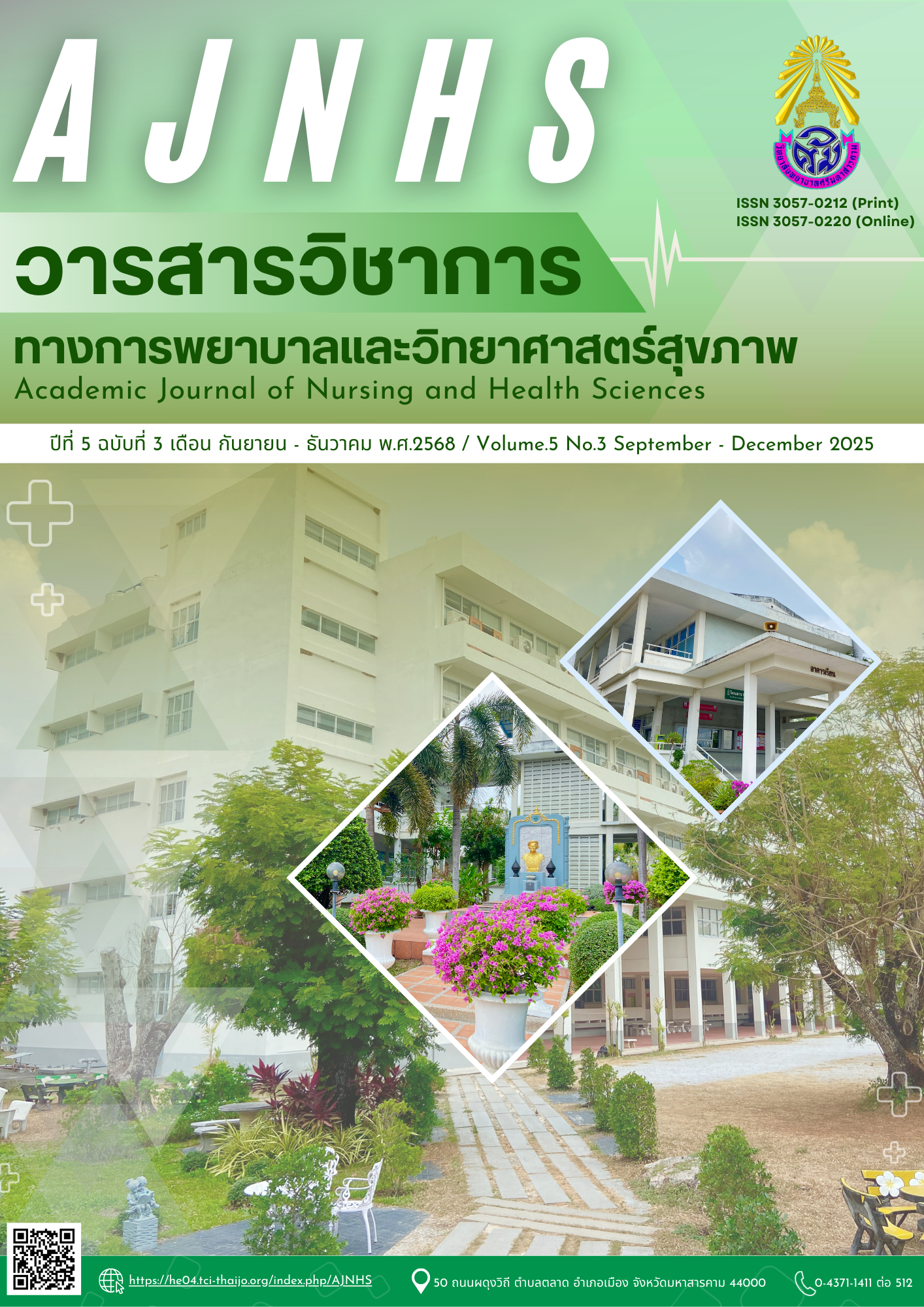Nursing Care for Patients with Complex Spinal Cord Injury in the Intermediate Care: 2 Cases Studies
Keywords:
intermediate-phase nursing care, spinal cord injury, complicationsAbstract
Spinal cord injury affects movement, sensation, and autonomic nervous system function, leading to physical, psychological, social, and quality-of-life impacts. The intermediate rehabilitation phase is crucial for functional recovery and the prevention of complications.
Objective: To compare complications, rehabilitation outcomes, and nursing care results among patients with spinal cord injury in the intermediate phase at different injury levels through two case studies.
Methods: Two patients with spinal cord injury in the intermediate phase were purposively selected. Both were admitted to the Rehabilitation Ward, Mahasarakham Hospital, between January and July 2025. A qualitative comparative case study design was employed. Research instruments included
a patient medical record review form and data collection on patient history, disease progression, and nursing care. Data were obtained from medical records and analyzed using Gordon’s Functional Health Patterns and Orem’s Self-Care Nursing Theory within the nursing process framework.
Results: The patient with a high-level injury (C4–C6) experienced multiple complications, including dysphagia, spasticity, autonomic dysreflexia, pressure ulcers, urinary tract infection, constipation, and depression. The Barthel Index score improved from 0 to 5, indicating a high level of dependence. The patient with a lower-level injury (T11–T12) had fewer complications, with the Barthel Index improving from 20 to 30, reflecting partial self-care ability and better rehabilitation outcomes. Both patients had an equal length of stay of 11 days.
Conclusion: The level of spinal cord injury directly influences the severity of complications and rehabilitation potential. Holistic assessment and individualized nursing care planning are essential to reduce complications and promote recovery. It is recommended to develop nursing care guidelines consistent with the level of injury and to enhance the self-care capacity of patients and families to improve long-term quality of life.
References
กิ่งแก้ว ปาจรีย์. (2561). การฟื้นฟูระบบประสาททันยุค 2561. กรุงเทพฯ: ภาควิชาเวชศาสตร์ฟื้นฟู คณะแพทยศาสตร์ศิริราชพยาบาล มหาวิทยาลัยมหิดล.
จิรภา สิงห์สูง. (2564). การพยาบาลผู้ป่วยที่มีการบาดเจ็บที่ไขสันหลังและไขสันหลังฟกซ้ำ. วารสารโรงพยาบาลสิงห์บุรี, 30(2), 53–61.
พัชรี บุตรแสนโคตร & จุฑามาศ คงกลาง. (2564). การพยาบาลเพื่อป้องกันภาวะแทรกซ้อนผู้ป่วยบาดเจ็บกระดูกสันหลังและไขสันหลังในระยะฟื้นฟู. ศรีนครินทร์เวชสาร, 36(5), 640–646.
สุพาพร ตันดี. (2565). การพยาบาลผู้บาดเจ็บกระดูกสันหลังระดับคอส่วนล่าง: กรณีศึกษา. วารสารสำนักงานสาธารณสุข จังหวัดขอนแก่น, 4(2), 328–329.
อัญชลี ยศกรณ์. (2564). การเกิดภาวะแทรกซ้อนในผู้ป่วยที่ได้รับการผ่าตัดกระดูกสันหลังในสถาบันประสาทวิทยา. วชิรสารการพยาบาล, 23(2), 44-56.
Ackery, A., Tator, C., & Krassioukov, A. (2004). A global perspective on spinal cord injury epidemiology. Journal of Neurotrauma, 21(10), 1355–1370. https://scihub.se/10.1089/neu.2004.21.1355
Berlowitz, D. J., Wadsworth, B., & Ross, J. (2016). Respiratory problems and management in people with spinal cord injury. Breathe, 12(4), 328–340. https://doi.org/10.1183/20734735.012616
Lindholm, B., & Vickery, T. (2023). Autonomic dysreflexia: Recognition and management. British Journal of Nursing, 32(2), 65–71. https://doi.org/10.12968/bjon.2023.32.2.65
Magnuson, F. S., Christensen, P., Krassioukov, A., Rodriguez, G., Emmanuel, A., Kirshblum, S., & Krogh, K. (2023). Neurogenic bowel dysfunction in patients with spinal cord injury and multiple sclerosis An updated and simplified treatment algorithm. Journal of Clinical
Medicine, 12(22), Article 6971. https://doi.org/10.3390/jcm12226971McDonald, J. W., & Sadowsky, C. (2002). Spinal-cord injury. The Lancet, 359(9304), 417–425. https://doi.org/10.1016/S0140-6736(02)07603-1
National Spinal Cord Injury Statistical Center. (2024). Traumatic Spinal Cord Injury Facts and figures at a glance. https://msktc.org/sites/default/files/Facts-and-Figures-2024-Eng-508.pdf
World Health Organization. (2023a). Spinal cord injury: Key facts. https://www.who.int/news room/fact-sheets/detail/spinal-cord-injury
World Health Organization. (2023b). International perspectives on spinal cord injury. https://www.who.int/publications/i/item/international-perspectives-on-spinal-cord-injury
Downloads
Published
How to Cite
Issue
Section
License

This work is licensed under a Creative Commons Attribution-NonCommercial-NoDerivatives 4.0 International License.


